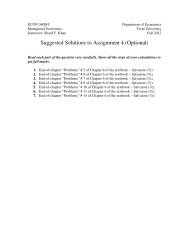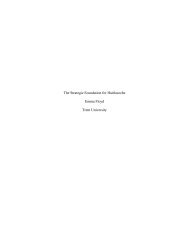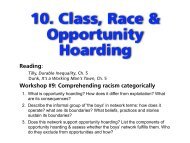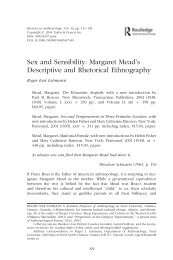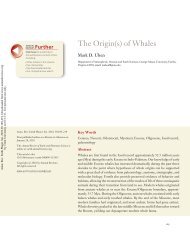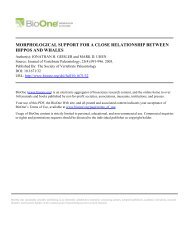REO FORTUNE'S PSYCHOLOGICAL THEORY OF CULTURAL ...
REO FORTUNE'S PSYCHOLOGICAL THEORY OF CULTURAL ...
REO FORTUNE'S PSYCHOLOGICAL THEORY OF CULTURAL ...
Create successful ePaper yourself
Turn your PDF publications into a flip-book with our unique Google optimized e-Paper software.
294 Pacifi c Studies, Vol. 32, Nos. 2/3—June/Sept. 2009<br />
Unsurprisingly, then, Fortune was among the published critics of Sex<br />
and Temperament in Three Primitive Societies. He wrote, somewhat<br />
awkwardly:<br />
Although the theory of Arapesh social culture having the one,<br />
uniform tendency, so called maternal, remains a hypothetical<br />
creation, it is not proper to assume that the Arapesh must be<br />
conceived either in terms of that hypothesis, or in terms of alternative<br />
hypothesis. It is better to make no hypotheses. (Fortune 1939,<br />
37)<br />
Fortune’s intellectual style shines through in his attack on Mead’s generalized<br />
depiction of Arapesh personality. In Mead’s writing on the Arapesh,<br />
in spite of rich description, she tended to rhetorically use idealized scenarios<br />
as though they were data, and made strong generalizations even when<br />
her own data contradicted these (Lohmann 2004, 112). Fortune criticized<br />
the accuracy of such blanket generalizations, and in the lines that follow,<br />
drew on specific data to support a more flexible picture of Arapesh<br />
culture-in-practice.<br />
Though Fortune and others have pointed to Mead’s tendency to ride<br />
roughshod over the details, Mead’s central point in Sex and Temperament,<br />
that gender is not determined by sex alone, stands as a monumental achievement<br />
in anthropology (Lipset 2003). But Fortune’s aversion to an etic,<br />
generalized picture of the cultures of both groups and individuals is clear.<br />
Lise Dobrin and Ira Bashkow (2006, 146) have shown that in comparison<br />
to Mead, Fortune exhibited an emic, empathetic, and particularist approach,<br />
and generally eschewed subordinating ethnographic data to theoretical<br />
frameworks.<br />
Ruth Benedict’s Patterns of Culture ([1934] 1953) inspired the intense<br />
discussions within the Sepik love triangle. While the book is a towering<br />
achievement in anthropology, it problematically likened cultures to individual<br />
personalities. Among the difficulties with early culture and personality<br />
studies was the tendency to reify cultures and stereotype cultural<br />
configurations. Ironically, Benedict used Fortune’s ethnography of Dobu<br />
as one of her exemplars. Susanne Kuehling (2005: 136–7) studied Dobu<br />
seventy years after Fortune and critiques his account, but calls Benedict’s<br />
boiled down version of Dobuan paranoia a “travesty.” Thomas (2009) has<br />
confirmed that in private, Fortune himself was similarly critical of Benedict’s<br />
use of his materials. Fortune’s pre-Mead dream-life and self-analyses<br />
indicate that before his fateful association with Mead, Benedict, and<br />
Bateson, he tended not to think of either individuals or groups in terms of<br />
pacs-32-02-06.indd 294 9/7/2009 2:32:34 PM



